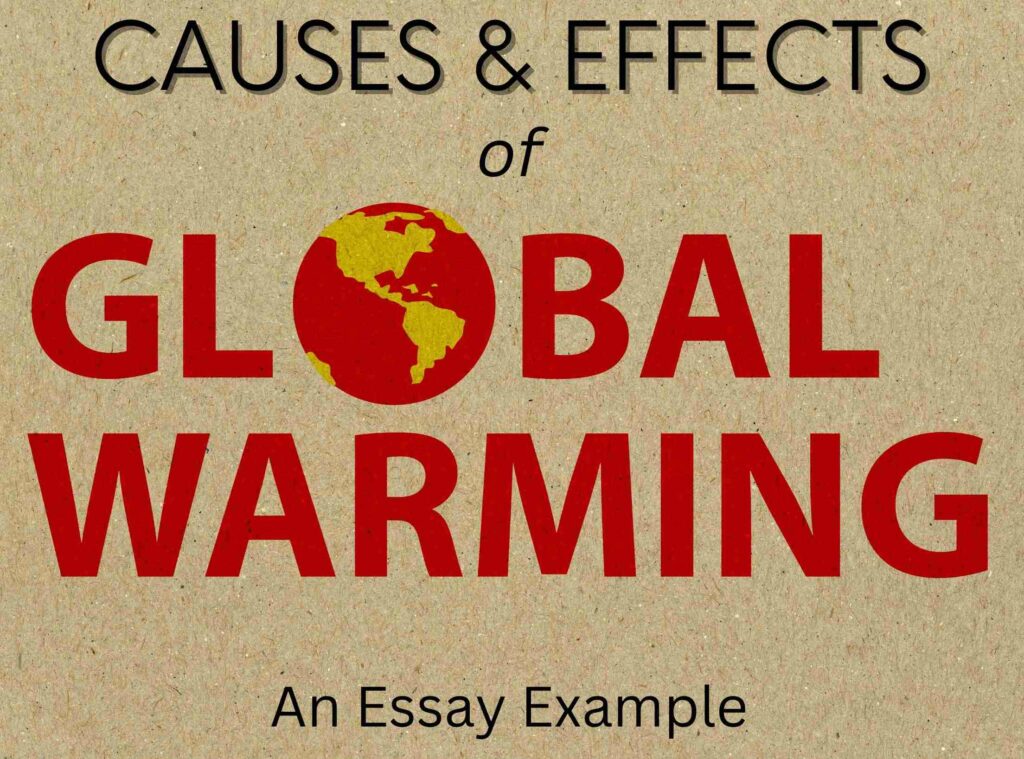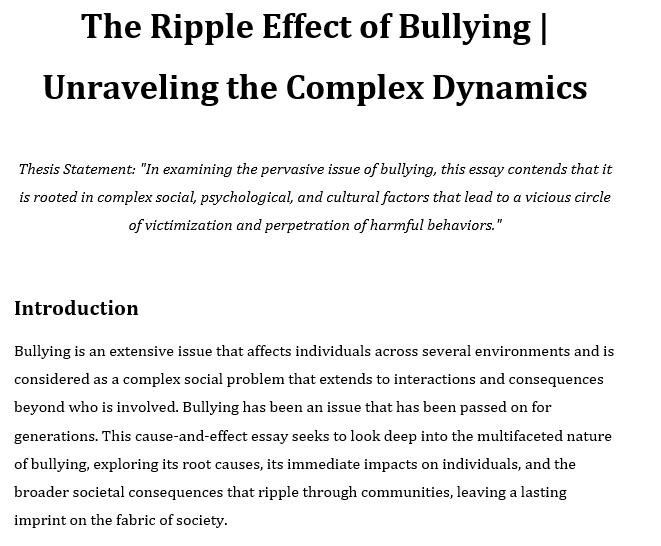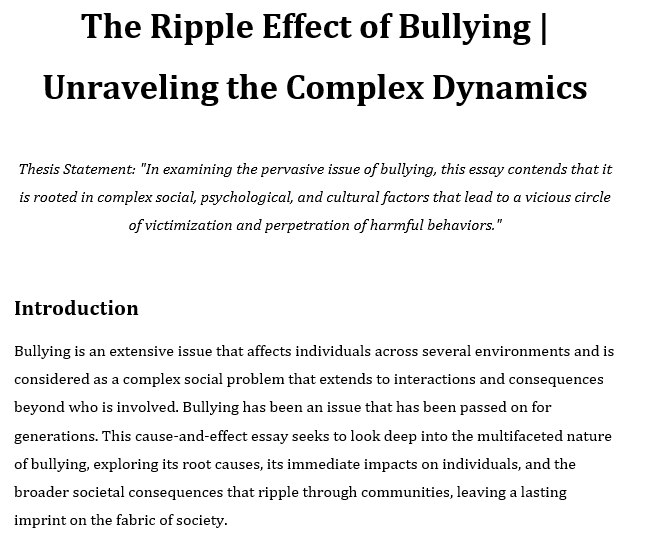If you are wondering how to write a cause and effect essay while preparing for your IELTS exam, this guide will serve as a roadmap. Writing a cause and effect essay for IELTS preparation involves structuring your response to demonstrate a clear understanding of the topic, logical organization of ideas, and effective language use.
Here’s a step-by-step guideline to help you:
1.
Understand the Prompt
Read the essay prompt carefully to identify the cause-and-effect relationship you need to discuss.
2.
Brainstorm Ideas
Organize your thoughts before starting the actual writing process. List potential causes and effects related to the given topic.
3.
Structure Your Essay
Write a short Introduction, followed by two paragraphs Cause and Effect with maximum two causes, and finally conclude the essay by summarizing it.
4.
Use Appropriate Vocabulary
Include a variety of vocabulary to showcase your language skills. Use cause-and-effect transitions like “because,” “due to,” “as a result,” “consequently,” etc.
5.
Proofread and Revise
Review your essay for flow, grammatical errors, spelling mistakes, and coherence. Make sure the word count is between 250-300 words.
Outline To Be Followed:
- Introduction
- Causes (Maximum 2 Causes)
- Effects (Maximum 2 Effects)
- Conclusion

Example # 1.
Topic: The Link Between Overeating, Sedentary Lifestyle, and Weight Gain
In today’s fast-paced world, the prevalence of sedentary lifestyles and overconsumption of food has become a significant health concern. This essay explores the causes and effects of gaining weight when individuals indulge in excessive eating without incorporating regular physical activity into their routines.
Causes of Weight Gain
- Cause 1: Overconsumption of Calories
One of the primary causes of weight gain is the overconsumption of calories. Modern diets often consist of highly processed and calorie-dense foods that contribute to an imbalance between the calories consumed and the calories burned. The accessibility of high-calorie snacks and large portion sizes further exacerbates this issue.
- Cause 2: Sedentary Lifestyle
A sedentary lifestyle, characterized by prolonged periods of sitting and minimal physical activity, is a significant contributor to weight gain. With the rise of desk jobs, technology-driven entertainment, and increased screen time, individuals are engaging in fewer activities that burn calories. The lack of regular exercise diminishes the body’s ability to maintain a healthy weight.
Effects of Weight Gain
- Effect 1: Obesity and Health Risks
The most immediate effect of excessive eating and insufficient exercise is obesity. Obesity is associated with various health risks, including cardiovascular diseases, diabetes, and hypertension. As a result of accumulation of excess body fat can lead to inflammation and metabolic imbalances, heightening the risk of chronic health conditions.
- Effect 2: Psychological Impact
Weight gain can have a profound psychological impact on individuals. The societal emphasis on body image and the stigma surrounding obesity can contribute to low self-esteem, body dissatisfaction, and even the development of eating disorders. Due to this, the psychological consequences of weight gain extend beyond physical health, affecting mental well-being.
Conclusion
The cause and effect essay examples IELTS is about gaining weight due to overeating and a sedentary lifestyle underscore the importance of maintaining a balanced approach to diet and exercise. By fostering healthy habits and making conscious choices, individuals can prevent the detrimental effects of weight gain on both physical and mental health.
Example # 2.
Topic: The Impact of Human Activities on Climate Change and Its Environmental Consequences
Introduction
Climate change, a phenomenon of increasing concern, is intricately linked to various human activities and natural processes. This cause and effect essay IELTS examples explores the causes and effects of climate change on the environment. The rise in global temperatures, primarily due to human-induced factors, has far-reaching consequences that necessitate urgent attention and action.
Causes of Climate Change
- Cause 1: Excessive Emission of Greenhouse Gasses
One of the main causes of climate change is the excessive emission of greenhouse gasses. The burning of fossil fuels for energy, deforestation, and industrial activities contribute significantly to the escalating levels of these gasses in the atmosphere. These human activities disrupt the natural balance, trapping heat and leading to the warming of the Earth.
- Cause 2: Deforestation
Moreover, deforestation amplifies the problem as trees play a crucial role in absorbing CO2 during photosynthesis. As forests diminish, the capacity to absorb these gasses decreases, exacerbating the greenhouse effect. The rapid industrialization and increased reliance on non-renewable energy sources further intensify the release of pollutants into the atmosphere, creating a vicious cycle of environmental degradation.
Effects of Climate Change
- Effect 1: Melting of Polar Ice Caps and Glaciers
One of the most evident consequences is the melting of polar ice caps and glaciers. The rise in global temperatures causes these icy expanses to shrink, contributing to rising sea levels. Consequently, coastal areas face the imminent threat of inundation, jeopardizing ecosystems and human settlements.
- Effect 2: Extreme Weather Events
Extreme weather events, such as hurricanes, droughts, and heatwaves, have become more frequent and severe due to climate change. These events not only pose a direct threat to human lives but also result in widespread destruction of infrastructure and agricultural land.
Conclusion
The causes and effects of climate change are intricately linked to human activities that release excessive greenhouse gasses into the atmosphere. The consequences are far-reaching, impacting ecosystems, weather patterns, and the livelihoods of people around the world. Urgent global action is imperative to mitigate these effects, transition towards sustainable practices, and preserve the environment for future generations.
Example # 3.
Topic: The Impact of Technology on Social Interaction
Introduction
In the contemporary digital era, the proliferation of technology has significantly altered the dynamics of social interaction. This IELTS cause and effect essay example digs into the causes and effects of technology’s impact on the way people communicate and connect. While technological advancements have brought convenience and connectivity, they have also engendered profound changes in the quality and depth of interpersonal relationships.
Causes of Transformation in Social Interaction
- Cause 1: Presence of Smartphones
The primary cause of the transformation in social interaction is the ubiquitous presence of smartphones and social media platforms. These tools offer instantaneous communication and connection, eliminating the barriers of time and space. Additionally, the allure of virtual interactions often draws individuals away from face-to-face communication, as the digital realm provides a curated and controlled environment for social engagement.
- Cause 2: Constant Influx of Information
Moreover, the rapid pace of technological development contributes to a constant influx of information and stimuli, creating a culture of constant connectivity. As a result, individuals may find themselves engrossed in their devices, diverting attention from the immediate physical environment and interpersonal engagements.
Effects of Transformation in Social Interaction
- Effect 1: Decline In Emotional Attachments
The effects of technology on social interaction manifest in various ways, with one notable consequence being a decline in the depth and authenticity of relationships. Virtual connections, while convenient, often lack the nuances and emotional richness of face-to-face communication.
- Effect 2: Culture of Comparison
Furthermore, the prevalence of social media fosters a culture of comparison and superficiality. People may present idealized versions of their lives online, contributing to feelings of inadequacy and fostering a disconnect between virtual personas and authentic selves. The constant exposure to curated online content can lead to a sense of isolation and an erosion of genuine human connection.
Conclusion
The causes and effects of technology on social interaction underscore the complex interplay between convenience and the potential erosion of genuine human connection. While technology offers unparalleled convenience and connectivity, it is crucial to navigate its impact consciously. Balancing digital interactions with meaningful face-to-face communication is imperative to maintain the authenticity and depth of interpersonal relationships in this tech-dominated era.
This is Izzah, a content writer and editor who creates SEO-friendly content and has experience in academic writing. Backed by 10 years of experience in writing and editing, she is equipped with the skill to create content that is backed by thorough research and has impeccable structure.




